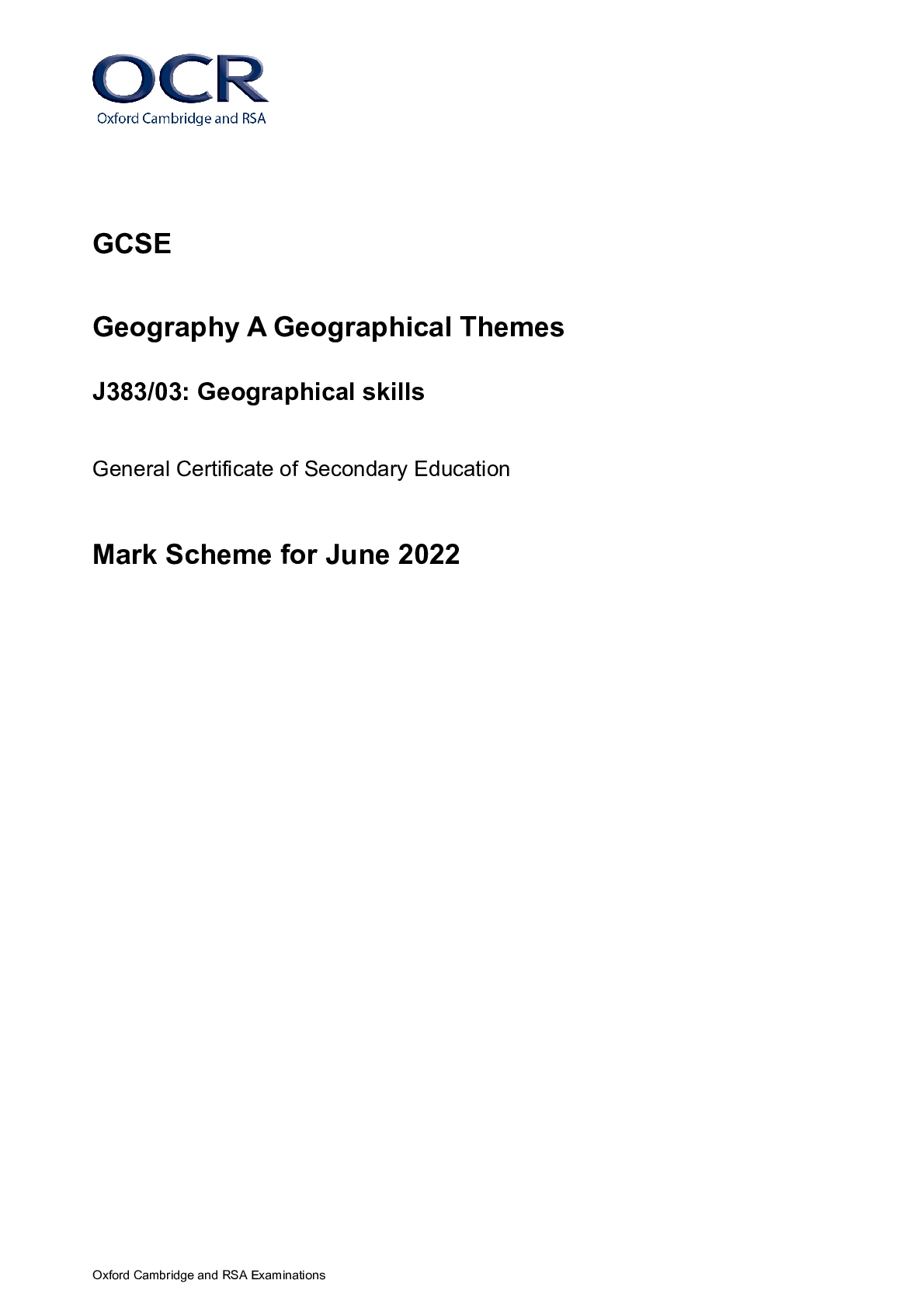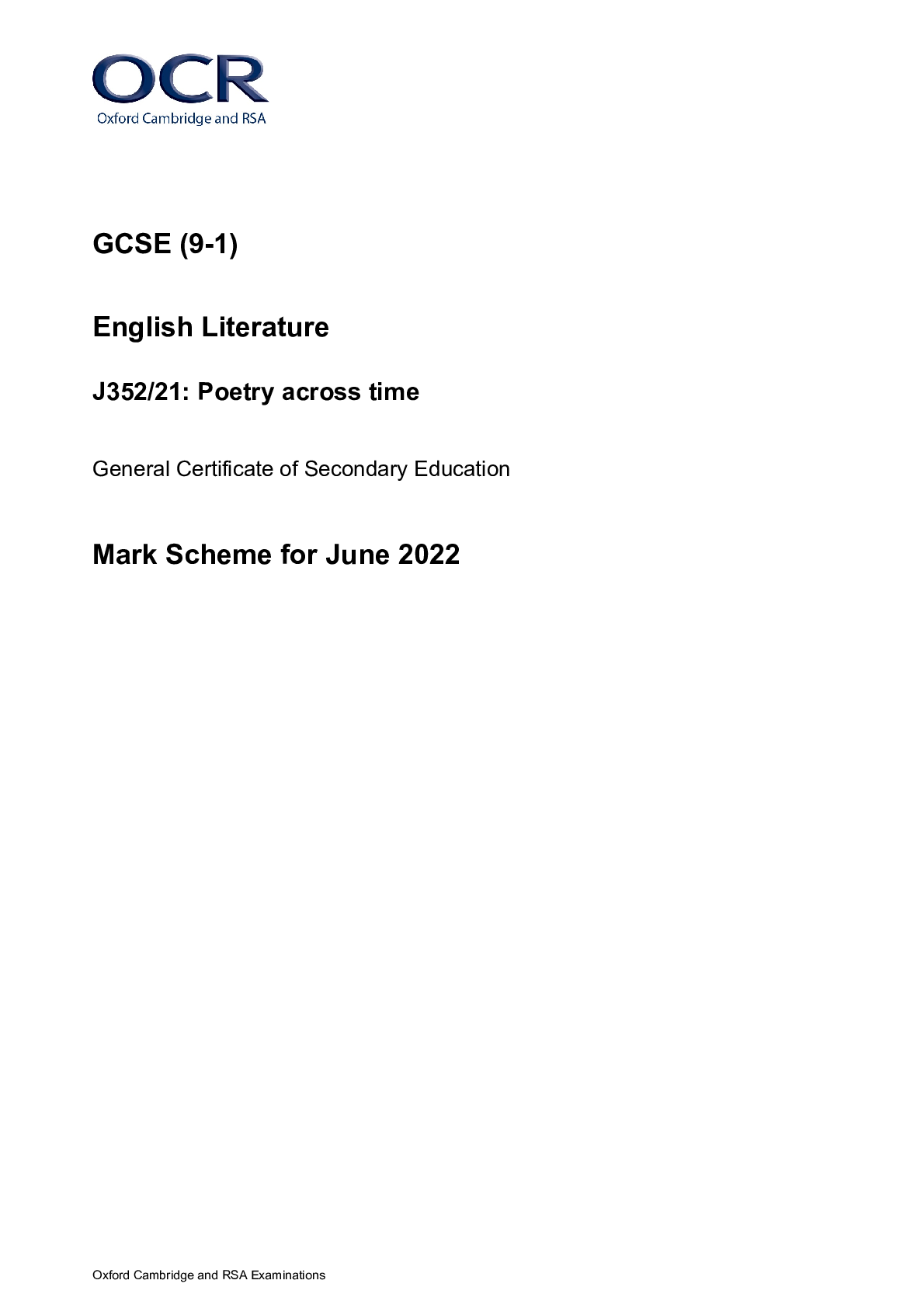Chemistry > GCSE MARK SCHEME > GCE Chemistry A H432/03: Unified chemistry Advanced GCE Mark Scheme for Autumn 2021 (All)
GCE Chemistry A H432/03: Unified chemistry Advanced GCE Mark Scheme for Autumn 2021
Document Content and Description Below
GCE Chemistry A H432/03: Unified chemistry Advanced GCE Mark Scheme for Autumn 2021 Oxford Cambridge and RSA Examinations GCE Chemistry A H432/03: Unified chemistry Advanced GCE Mark Scheme for ... Autumn 2021Oxford Cambridge and RSA Examinations OCR (Oxford Cambridge and RSA) is a leading UK awarding body, providing a wide range of qualifications to meet the needs of candidates of all ages and abilities. OCR qualifications include AS/A Levels, Diplomas, GCSEs, Cambridge Nationals, Cambridge Technicals, Functional Skills, Key Skills, Entry Level qualifications, NVQs and vocational qualifications in areas such as IT, business, languages, teaching/training, administration and secretarial skills. It is also responsible for developing new specifications to meet national requirements and the needs of students and teachers. OCR is a not-for-profit organisation; any surplus made is invested back into the establishment to help towards the development of qualifications and support, which keep pace with the changing needs of today’s society. This mark scheme is published as an aid to teachers and students, to indicate the requirements of the examination. It shows the basis on which marks were awarded by examiners. It does not indicate the details of the discussions which took place at an examiners’ meeting before marking commenced. All examiners are instructed that alternative correct answers and unexpected approaches in candidates’ scripts must be given marks that fairly reflect the relevant knowledge and skills demonstrated. Mark schemes should be read in conjunction with the published question papers and the report on the examination. © OCR 2021H432/03 Mark Scheme October 2021 2 1. Annotations Annotation Meaning Correct response Incorrect response Omission mark Benefit of doubt given Contradiction Rounding error Error in number of significant figures Error carried forward Level 1 Level 2 Level 3 Benefit of doubt not given Noted but no credit given IgnoreH432/03 Mark Scheme October 2021 3 2. Abbreviations, annotations and conventions used in the detailed Mark Scheme (to include abbreviations and subject-specific conventions). Annotation Meaning DO NOT ALLOW Answers which are not worthy of credit IGNORE Statements which are irrelevant ALLOW Answers that can be accepted ( ) Words which are not essential to gain credit __ Underlined words must be present in answer to score a mark ECF Error carried forward AW Alternative wording ORA Or reverse argumentH432/03 Mark Scheme October 2021 4 Question Answer Marks AO element Guidance 1 (a) FIRST CHECK THE ANSWER ON ANSWER LINE If answer = 20 award 2 marks -------------------------------------------------------------------------- n(CO2) = 110 44 OR 2.5 (mol) AND n(O2) = 120 32 OR 3.75 (mol) p(CO2) = 6.25 2.5 × 50.0 OR 0.4 × 50.0 = 20(.0) (atm) 2 AO1.2 × 2 ALLOW ECF from incorrect Σ ( n(CO2) + n(O2) ) ONLY (b) FIRST CHECK THE ANSWER ON ANSWER LINES If [PCl3] = [Cl2] = 0.02(00) award 2 marks -------------------------------------------------------------------------- Kc = [PCl3] [Cl2] [PCl5] OR with number(s), e.g. Kc = [PCl 0.053] [Cl (00)2] [PCl3] = [Cl2] = √(Kc × [PCl5] ) = √(8.00 × 10–3 × 0.0500 ) = √(4.00 × 10–4) = 2.00 × 10–2 (mol dm–3) 2 AO1.1 AO2.2 Square brackets required ------------------------------------------------------------ Common errors 2.00 × 10–4 from Kc = [PCl3] [Cl2] [PCl5] 1 mark ÷2 instead of √ 2.5 from Kc = [PCl5] [PCl3] [Cl2] 1 mark Inverse Kc expressionH432/03 Mark Scheme October 2021 5 Question Answer Marks AO element Guidance Electronegativity and boiling point Boiling point/Energy increases with increased electronegativity (difference) Type of intermolecular force HF AND NH3 have hydrogen bonding AND CH4 has London forces/induced (dipole–)dipole interactions Comparison between strength of intermolecular forces HF has stronger hydrogen bonding than NH3 OR hydrogen bonding is stronger than London forces 3 AO1.1 AO1.2 AO2.1 ANNOTATE WITH TICKS AND CROSSES ALLOW ORA throughout ------------------------------------------------------------------- ORA IGNORE permanent dipole interactions IGNORE IDID IGNORE HF and NH3 are polar/CH4 is non-polar IGNORE strength of ionic and covalent bonds (d) A: Ca3N2 (formula required) B: NH3 OR ammonia C: Ca(OH)2 OR calcium hydroxide Equation: Ca3N2 + 6H2O → 2NH3 + 3Ca(OH)2 4 AO1.1 AO2.7 ×2 AO2.6 IGNORE working If B and C labels are the wrong way round OR missing, award 1/2 for B and C labels, i.e. for B Ca(OH)2 C NH3 1/2 marks ALLOW CaO2H2 ALLOW multiples for equation IF C = CaO, ALLOW ECF for: Ca3N2 + 3H2O → 2NH3 + 3CaOH432/03 Mark Scheme October 2021 6 Question Answer Marks AO element Guidance (e) 2CH3CH(OH)COOH + Na2CO3 → 2CH3CH(OH)COONa + CO2 + H2O CO2 and H2O OR CH3CH(OH)COONa as product(s) Balanced equation correct 3CH3CH(OH)COOH + Al → (CH3CH(OH)COO)3Al + 1½ H2 H2 OR (CH3CH(OH)COO)3Al as product Balanced equation correct 4 AO2.6 ×4 ALLOW multiples IGNORE state symbols ALLOW ions shown separately For CO2 AND H2O, ALLOW H2CO3 ALLOW ….COONa+ (i.e. one of charges missing) ALLOW ….COO)3Al3+ (i.e. one of charges missing)H432/03 Mark Scheme October 2021 7 Question Answer Marks AO element Guidance (f) Mechanism: NOTE: Can be any C–X bond, e.g. C–Cl, C–Br, C–I but must be consistent. Curly arrow on C–X Dipole shown on C–X bond of CH3X, Cδ+ and Xδ– AND curly arrow from C−X bond to X atom Curly arrow from CH3COO– Curly arrow from CH3COO– to C atom of C–X bond ----------------------------------------------------------------------------- Products Correct organic product AND X– 3 AO2.5 AO1.2 AO2.5 ANNOTATE ANSWER TICKS AND CROSSES -------------------------------------------------------------- NOTE: Curly arrows can be straight, snake-like, etc. but NOT double headed or half headed arrows 1st curly arrow must start from, OR be traced back to, any part of C–Cl bond and go to Cl 2nd curly arrow must • go to the C of C–Cl AND • start from, OR be traced back to any point across width of lone pair on O of CH3COO– • OR start from ‘–‘ on O of CH3COO– ion --------------------------------------------------------------- If CH3COOH used instead of CH3COO–, ALLOW X– OR HX as 2nd product (Lone pair NOT needed if curly arrow from O–)H432/03 Mark Scheme October 2021 8 Question Answer Marks AO element Guidance ALLOW SN1 mechanism First mark Dipole shown on C–Cl bond, Cδ+ and Clδ−, AND curly arrow from C−Cl bond to Cl atom Second mark Correct carbocation AND curly arrow from CH3COO– to carbocation Curly arrow must be from lone pair on O of CH3COO– OR from minus on O of CH3COO– ion (no need to show lone pair if curly came from – charge) Third mark Correct organic product AND Cl– H432/03 Mark Scheme October 2021 9 Question Answer Marks AO element Guidance 2 (a) Closed system that would work (Labels not required) Reaction apparatus with tube/side arm AND gas collection apparatus AND closed system Labels Reaction apparatus, e.g.: Conical flask, Buchner flask/conical flask with side arm, test-tube, boiling tube. AND Gas collection apparatus: (gas) syringe OR gas collection over water with labelled measuring cylinder / burette 2 AO3.3 × 2 ALLOW small gaps provided there is an attempt to show closed system DO NOT ALLOW delivery tube below reaction mixture For reaction apparatus, • DO NOT ALLOW flask, volumetric flask, beaker, measuring cylinder • Delivery tube, bung does NOT need a label ALLOW labels for diagram without closed system (e.g. bung missing), i.e. 2nd mark but not 1st mark ALLOW any of these diagrams. ALLOW a single line for the tube IGNORE Sealed end of delivery tube IGNORE size of syringe/measuring cylinder/buretteH432/03 Mark Scheme October 2021 10 Question Answer Marks AO element Guidance (b) n(H2) = 24000 152 OR 6.33…. × 10–3 (mol) n(Eu) = 0.988 152 OR 6.5(0) × 10–3 (mol) Ratio H2 : Eu 1 : 1 AND Equation 2 is correct Only ALLOW if n(H2) AND n(Eu) are approximately equal ALLOW use of ideal gas equation at a reasonable temperature and pressure. e.g. Using 100 kPa and 298 K, n(H2) = 6.14 × 10–3 mol 3 AO2.8 ×2 AO3.2 ×1 152 6.5(0) × 10–3 (mol) ALLOW 0.97(4) : 1 ALLOW ECF from incorrect n(Eu) OR/AND n (H2) ---------------------------------------------------------------- ALLOW approach that calculates mass Eu from 6.33…. × 10–3 mol H2 for each equation, e.g. Equation 1: 2 × 6.33 × 10–3 × 152 = 1.9.. g Equation 2: 1 × 6.33 × 10–3 × 152 = 0.96.. g Equation 3: 2/3 × 6.33 × 10–3 × 152 = 0.64.. g 0.988 matched to 0.96 g and Equation 2 Use judgment ---------------------------------------------------------------- ALLOW approach that calculates volume H2 from 6.50 × 10–3 mol Eu for each equation, e.g. Equation 1: 0.5 × 24000 × 6.50 × 10–3 = 78 cm3 Equation 2: 1 × 24000 × 6.50 × 10–3 = 156 cm3 Equation 3: 1.5 × 24000 × 6.50 × 10–3 = 234 cm3 152 matched to 156 cm3 and Equation 2 Use judgmentH432/03 Mark Scheme October 2021 11 Question Answer Marks AO element Guidance (c) The gas volume would be larger (than at RTP) Ratio H2 : Eu would be larger 2 AO3.4 ×2 IGNORE effect of rate, e.g. rate increases IGNORE gas equation should be used to find n(H2) ALLOW Equation 3 linked to H2 : Eu > 1 (d) Qual Precipitates have different molar masses OR Precipitates have different formulae Quant Equation 2 forms precipitate with M = 186 OR with formula Eu(OH)2 OR Equation 2 forms 1.86 g precipitate OR Molar mass M of precipitate = mass of precipitate moles precipitate OR mass of precipitate moles Eu OR mass of precipitate 0.01 2 AO3.4 ×2 ALLOW precipitates are EuOH, Eu(OH)2 Eu(OH)3 OR precipitates have different number of OH– ions ALLOW Moles OH– = mass of precipitate – mass of Eu molar mass of OH– OR Moles OH– = mass of precipitate –1.52 17H432/03 Mark Scheme October 2021 12 Question Answer Marks AO element Guidance 3 (a) n(Ba(OH)2) = 0.150 × 1000 250 OR 0.0375 (mol) Mass Ba(OH)2 = 0.0375 × 171.3 = 6.42375 (g) Dissolve solid in (distilled) water (less than 250 cm3) in beaker Transfer (solution) to volumetric flask AND Transfer washings (from beaker) to flask Make up to mark/up to 250 cm3 with (distilled) water AND Invert flask (several times to ensure mixing) 5 AO2.4 ×2 AO1.2 ×3 ALLOW ECF from incorrect n(Ba(OH)2) ALLOW 6.42 up to 6.42375 correctly rounded 6.42 g subsumes 1st mark ALLOW conical flask for beaker ALLOW graduated flask DO NOT ALLOW round-bottom or conical flask (b) n(Ba(OH)2) = 0.150 × 23.5 10000 = 3.525 × 10–3 (mol) n(D) in 25.0 cm3 = 2 × 3.525 × 10–3 = 7.05 × 10–3 (mol) n(D) in 100 cm3 = 7.05 × 10–3 × 25.0 100 = 0.0282 (mol) Molar mass (D) = 0.0282 3.215 = 114 (g mol–1) Formula: = C5H9COOH OR CnH2n–1: M(C5H9) = 114 – 45 = 69 If not stated, could be credited from structure 7 AO2.8 ×4 AO3.2 ×1 Use ECF throughout Intermediate values for working to at least 3 SF. TAKE CARE as value written down may be truncated value stored in calculator. Depending on rounding, either can be credited. ---------------------------------------------------------------- ALLOW Mass D in 25.0 cm3 = 3.215 4 = 0.80375 g Molar mass (D) = 0.80375 7.05 × 10–3 = 114H432/03 Mark Scheme October 2021 13 Question Answer Marks AO element Guidance cis stereoisomers. The drawn stereoisomers must have • Different groups attached to each C atom of C=C • Each C of C=C has the same group on the same side Any 2 cis isomers Many possibilities, e.g. ALLOW correct structural, with ‘cis’ part displayed OR skeletal OR displayed formula OR mixture of above as long as non-ambiguous ALLOW side chains as molecular formula, e.g. C3H7 for (CH3)2CH OR CH3CH2CH2 e.g. C3H5O2 for CH2CH2COOH IGNORE poor connectivity to all groups AO3.2 ×2 COMMON ERRORS: Up to Molar mass = 114 (1st 4 marks) M = 456 → 3/4 marks (mol in 100 cm3 omitted) M = 3.215 7.05 × 10–3 = 456 M = 228 → 3/4 marks (No × 2 for n(D)) 3.525 × 10–3 × 100 25.0 = 0.0141 M = 3.215 0.0141 = 228 M = 100.8 → 3/4 marks 23.50 instead of 25.00 and scaling by × 23.50 100 25.0 × 0.150 1000 = 3.75 × 10–3 → 2 × 3.75 × 10–3 = 7.5 × 10–3 → 7.5 × 10–3 × 100 23.50 = 0.0319 → 3.215 0.0319 → 100.8 THEN ALLOW ECF for carboxylic acid closest to calculated M(alkyl group) but must be CnH2n–1 e.g. For M(alkyl) = 100, ALLOW C4H7 (55) For M(alkyl) = 411, ALLOW C29H57 (405) OR C30H59 (419) THEN judge cis isomers with closest match ALLOW 1 mark for 2 trans isomers shown instead of 2 cis isomers ECF for Same error made twice.H432/03 Mark Scheme October 2021 14 Question Answer Marks AO element Guidance 4 (a) (Large) excess of pent-1-ene OR There is a (large) excess 1 AO3.1 ALLOW pent-1-ene concentration is (much) greater OR pent-1-ene has a high concentration (b) Please refer to the marking instructions on page 6 of this mark scheme for guidance on how to mark this question. Level 3 (5–6 marks) Obtains a comprehensive conclusion to determine initial rate AND order AND rate constant k There is a well-developed line of reasoning which is clear and logically structured. The information presented is relevant and substantiated. Level 2 (3–4 marks) Obtains a sound, but not comprehensive conclusion, to determine initial rate AND order OR order AND rate constant k OR initial rate AND rate constant k There is a line of reasoning presented with some structure. The information presented is relevant and supported by some evidence. Level 1 (1–2 marks) Obtains a simple conclusion to determine initial rate OR order There is an attempt at a logical structure with a line of reasoning. The information is in the most part relevant. 0 marks No response or no response worthy of credit. 6 AO3.1 ×4 AO3.2 ×2 Indicative scientific points may include: Initial rate • Evidence of tangent on graph drawn to line at t = 0 s AND gradient determined in range 4.5 – 6.5 × 10–6 • initial rate expressed as gradient value with units of mol dm–3 s–1, e.g. initial rate = 5.5 × 10–6 mol dm–3 s–1 Reasoned order of I2 Half lives • Half life measured on graph OR within text OR stated in range 2500 ±10 s • Constant half life OR two stated half lives within ±10 s AND conclusion that I2 is 1st order OR Comparison of rates from gradients • Rate measured as gradient at a concentration, c • Rate measured at c/2 • c halves and rate halves • so order 1 e.g. initial rate at c = 0.02 = 5.5 × 10–6 mol dm–3 s–1 rate at c = 0.01 = 2.58 × 10–6 mol dm–3 s–1H432/03 Mark Scheme October 2021 15 Question Answer Marks AO element Guidance Determination of k with units • Rate constant k clearly linked to initial rate OR half-life: k = rate [I2] OR k = ln 2 t1/2 • k determined correctly from measured initial rate or measured half life with units of s–1, e.g. k = 5.5 × 10 0.02 –6 = 2.75 × 10–4 s–1 from initial rate of 5.5 × 10–6 mol dm–3 s–1 OR from t1/2 of 2500 s • Typical range 2.25–3.25 × 10–4 (c) (i) Reactants for 1st step: CH3CH2CH2CH=CH2 + I2 2 steps that add up to overall equation: CH2CH2CH=CH2 + I2 → CH3CH2CH2CHICH2I e.g. CH3CH2CH2CH=CH2 + I2 → CH3CH2CH2CHICH2+ + I– CH3CH2CH2CHICH2+ + I– → CH3CH2CH2CHICH2I 2 AO2.5 × 2 ALLOW mechanism for electrophilic addition shown. IGNORE state symbols Must be based on slow step, i.e. 2nd mark dependent on correct slow step: CH3CH2CH2CH=CH2 + I2 IGNORE actual positioning of + charge ALLOW → CH3CH2CH2CHICH2 + I (no charge) CH3CH2CH2CHICH2 + I → (ii) Repeat experiment with [I2] constant/kept the same OR use (large) excess of I2 Monitor/measure/plot [CH3CH2CH2CH=CH2] over time OR Monitor/measure how [CH3CH2CH2CH=CH2] affects rate 2 AO3.4 ×2 ALLOW I2 in (great) excess ALLOW initial rates approach of running several experiments with different concentrations of CH3CH2CH2CH=CH2 i.e. Measure initial rates for each experiment AND double concentration → rate doublesH432/03 Mark Scheme October 2021 16 Question Answer Marks AO element Guidance 5 (a) (i) Reduction: Na+ + e– → Na Oxidation: 2N3– → 3N2 + 2e– ALLOW 1 mark for 2 correct equations but wrong way round 2 AO1.2 ALLOW multiples e.g. 2Na+ + 2e– → 2Na IGNORE state symbols (ii) FIRST CHECK ANSWER ON ANSWER LINE IF mass = 34.5 (g) AND working using ideal gas equation Award 5 marks for calculation -------------------------------------------------------------------------- Rearranging ideal gas equation n = pV RT Unit conversion AND substitution into n = pV RT : • R = 8.314 OR 8.31 • V = 16(.0) × 10–3 • T in K: 290 K e.g. 1.20 × 105 × 16.0 × 10–3 8.314 × 290 Calculation of n n = 0.796 (mol) Calculation of mass n(NaN3) = 2 3 × 0.796 = 0.531 (mol) mass NaN3 = 0.531 × 65 = 34.5 (g) 3 SF required 5 AO2.4 ×5 TAKE CARE as value written down may be truncated value stored in calculator. IF n = pV RT is omitted, ALLOW when values are substituted into rearranged ideal gas equation. Calculator: 0.7963302448 From unrounded 0.7963302448, n(NaN3) = 0.5308868299 mass = 0.5308868299 × 65 = 34.50764394 → 34.5 to 3 SF COMMON ERROR 51.7 OR 51.8 → 4 marks (2/3 omitted depending on intermediate rounding 0.796 × 65 = 51.7 OR 51.8 54.4 → 4 marks (inverted gas equation) n = RT pV →1.255760417→ 0.8371736111 → 54.4 (g) CARE with intermediate rounding 81.6 OR 81.7 → 3 mks (as above but no 2/3)H432/03 Mark Scheme October 2021 17 Question Answer Marks AO element Guidance (b) (i) FIRST CHECK THE ANSWER ON ANSWER LINE If answer = 2.75 award 2 marks -------------------------------------------------------------------------- [H+]2 = Ka × [HN3]) = 2.51 × 10–5 × 0.125 [H+] = √(Ka × [HN3]) [H+]2 = 2.51 × 10–5 × 0.125 OR [H+] = √ (2.51 × 10–5 × 0.125) OR [H+] =1.77…. × 10–3 (mol dm–3) pH = –log 1.77…. × 10–3 = 2.75 (Must be to 2DP) 2 AO2.2 ×2 ALLOW ECF throughout IGNORE error with HN3 shown as NH3 ALLOW pH mark by ECF ONLY if 2.51 × 10–5 × 0.125 used AND pH <7 --------------------------------------------------------- Common errors (Must be to 2 DP) pH = 5.50 → 1 mark (No square root) [H+] = 6.26 × 10–4 from √ (2.51 × 10–5 ) × 0.125 pH = 3.20 → 1 mark [H+] = 8.87 × 10–6 from √ (0.125) × 2.51 × 10–5 pH = 5.05 → 1 mark (ii) • Correct equation • Correct acid–base pair labels for correct equation HN3 + H2O N3– + H3O+ A1 B2 B1 A2 OR A2 B1 B2 A1 2 AO1.2 ×2 ALLOW 1 mark for one correct acid–base pair WITH correct labels e.g. H2O H3O+ WITH B1 A1 OR B2 A2H432/03 Mark Scheme October 2021 18 Question Answer Marks AO element Guidance (iii) Structure of 2-methylbutanoic acid Structure of organic product (primary amine) CO2 AND N2 as products 3 AO3.2 ×2 AO2.6 ALLOW correct structural OR skeletal OR displayed formula OR mixture of the above as long as non-ambiguous Common error With NH3, → CO2 + H2 ALLOW ECF for equation using a different amine isomer of the organic product e.g. (CH3)2CHCH2NH2 DO NOT ALLOW ECF from unbranched species, e.g. CH3CH2CH2NH2 IGNORE HN3 in equation, even if missing IGNORE poor connectivity to all groupsH432/03 Mark Scheme October 2021 19 Question Answer Marks AO element Guidance (c)* Please refer to the marking instructions on page 6 of this mark scheme for guidance on how to mark this question. Level 3 (5–6 marks) Reaches a comprehensive conclusion to determine the correct formulae of almost all of E, F, G, H, I and J There is a well-developed line of reasoning which is clear and logically structured. The information presented is relevant and substantiated. Level 2 (3–4 marks) Reaches a sound conclusion to determine the correct formulae of at least half of E, F, G, H, I and J There is a line of reasoning presented with some structure. The information presented is relevant and supported by some evidence. Level 1 (1–2 marks) Reaches a simple conclusion to determine the correct formulae of some of E, F, G, H, I and J There is an attempt at a logical structure with a line of reasoning. The information is in the most part relevant. 0 marks No response or no response worthy of credit. 6 AO3.1 ×2 AO3.2 ×4 Indicative scientific points may include: Identify of E, F, G, H, I and J • E Cu/copper • F: H2O/water • G: N2/nitrogen • H: CH3COCl OR ClCH2CHO OR C2H3OCl • I: CH3CONH2 OR H2NCH2CHO • J: NH4Cl/ammonium chloride Examples of reasoning Working n(CuO) = 4.77 (63.5 + 16) = 0.06 (mol) M(E) = 3.81 ÷ 0.06 = 63.5 n(G) = 24000 480 = 0.02 M(G) = 0.560 0.02 = 28 (g mol–1) Infrared spectrum I contains • C=O ( ~1700 cm–1) • NH2 ( ~3200–3400 cm–1) Equations 3CuO + 2NH3 → 3Cu + 3H2O + N2 CH3COCl + 2NH3→ CH3CONH2 + NH4Cl OR ClCH2CHO + 2NH3→ H2NCH2CHO + NH4ClOCR (Oxford Cambridge and RSA Examinations) The Triangle Building Shaftesbury Road Cambridge CB2 8EA OCR Customer Contact Centre Education and Learning Telephone: 01223 553998 Facsimile: 01223 552627 Email: [email protected] [Show More]
Last updated: 1 year ago
Preview 1 out of 21 pages
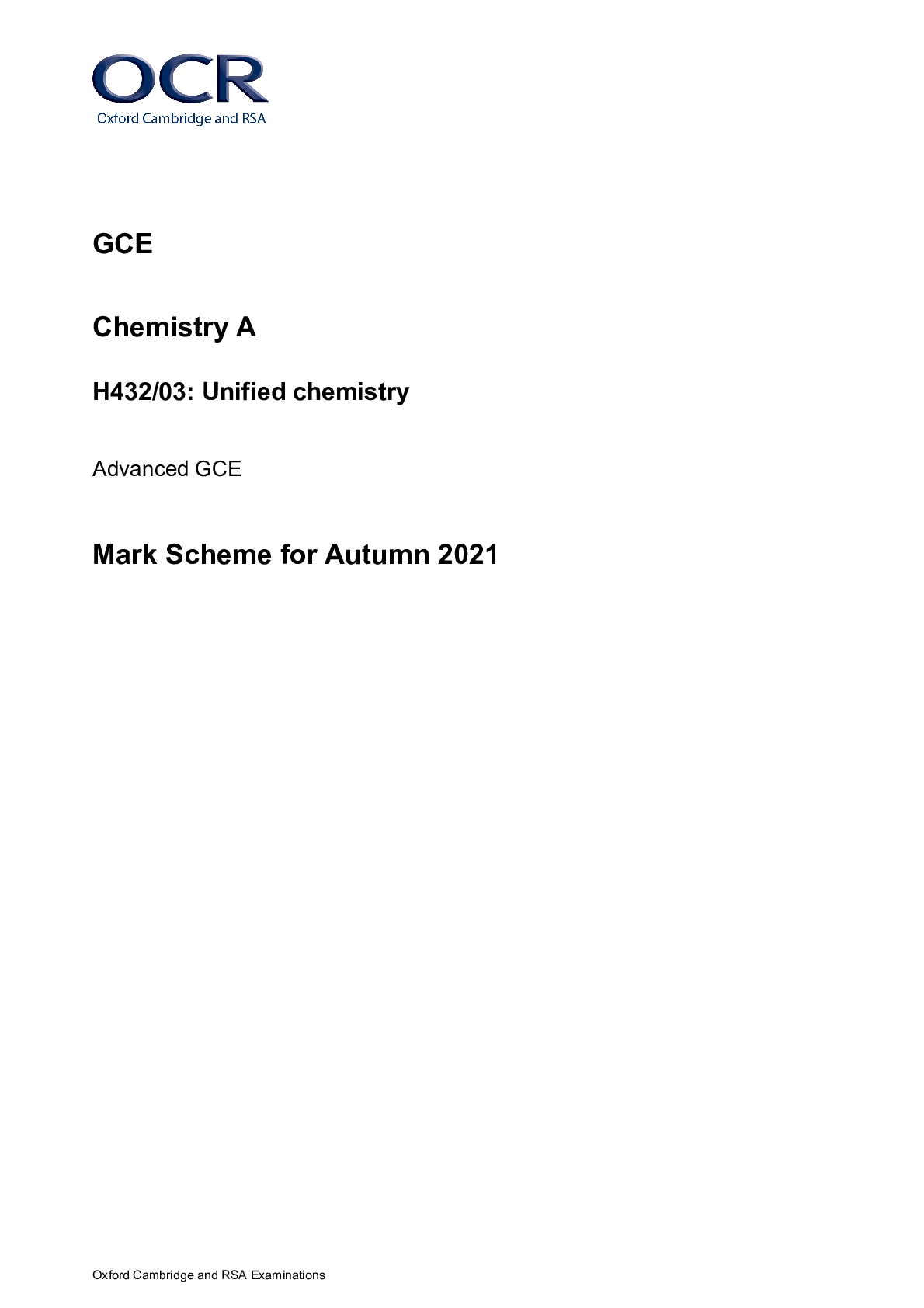
Reviews( 0 )
Document information
Connected school, study & course
About the document
Uploaded On
Oct 07, 2022
Number of pages
21
Written in
Additional information
This document has been written for:
Uploaded
Oct 07, 2022
Downloads
0
Views
45



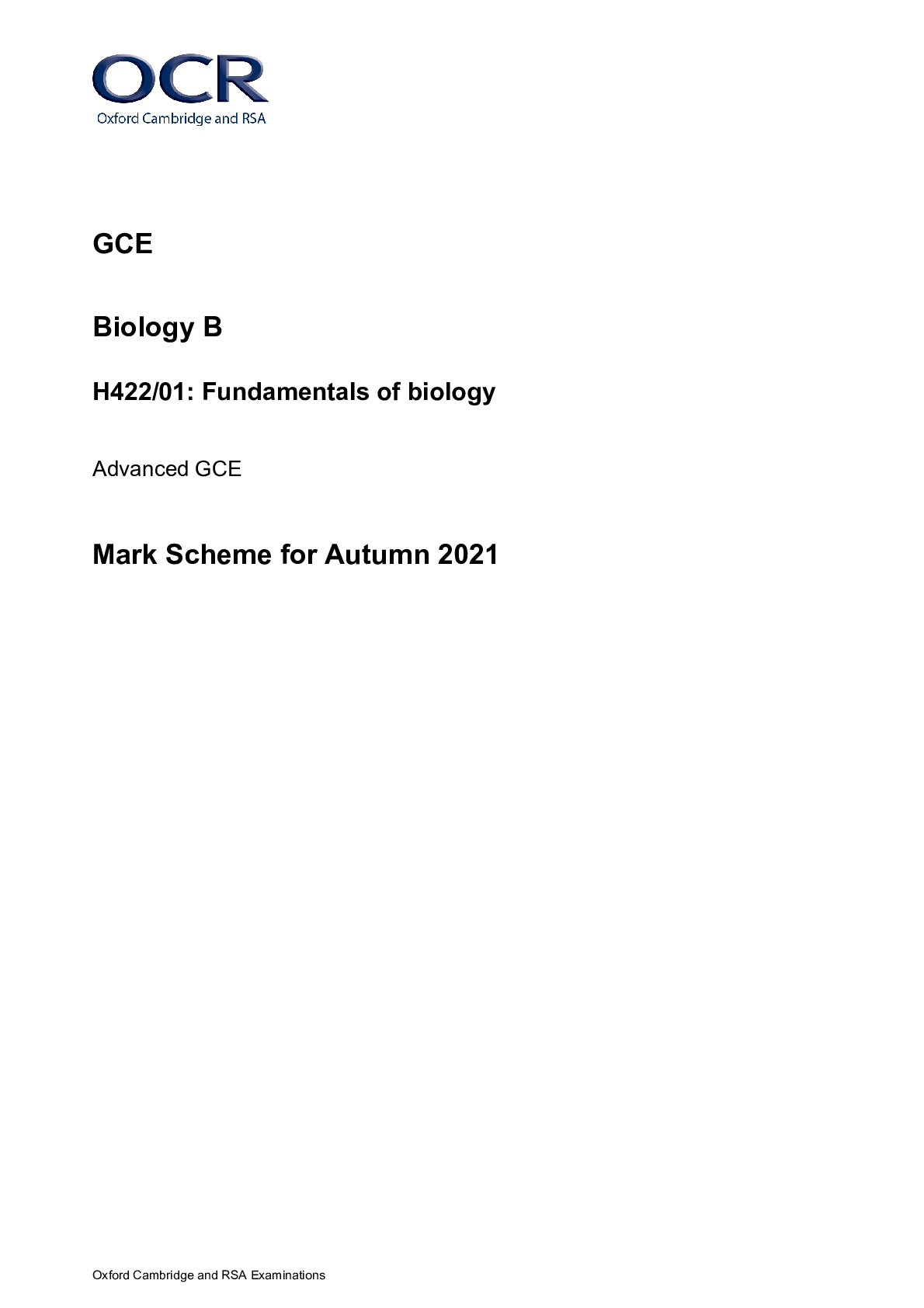
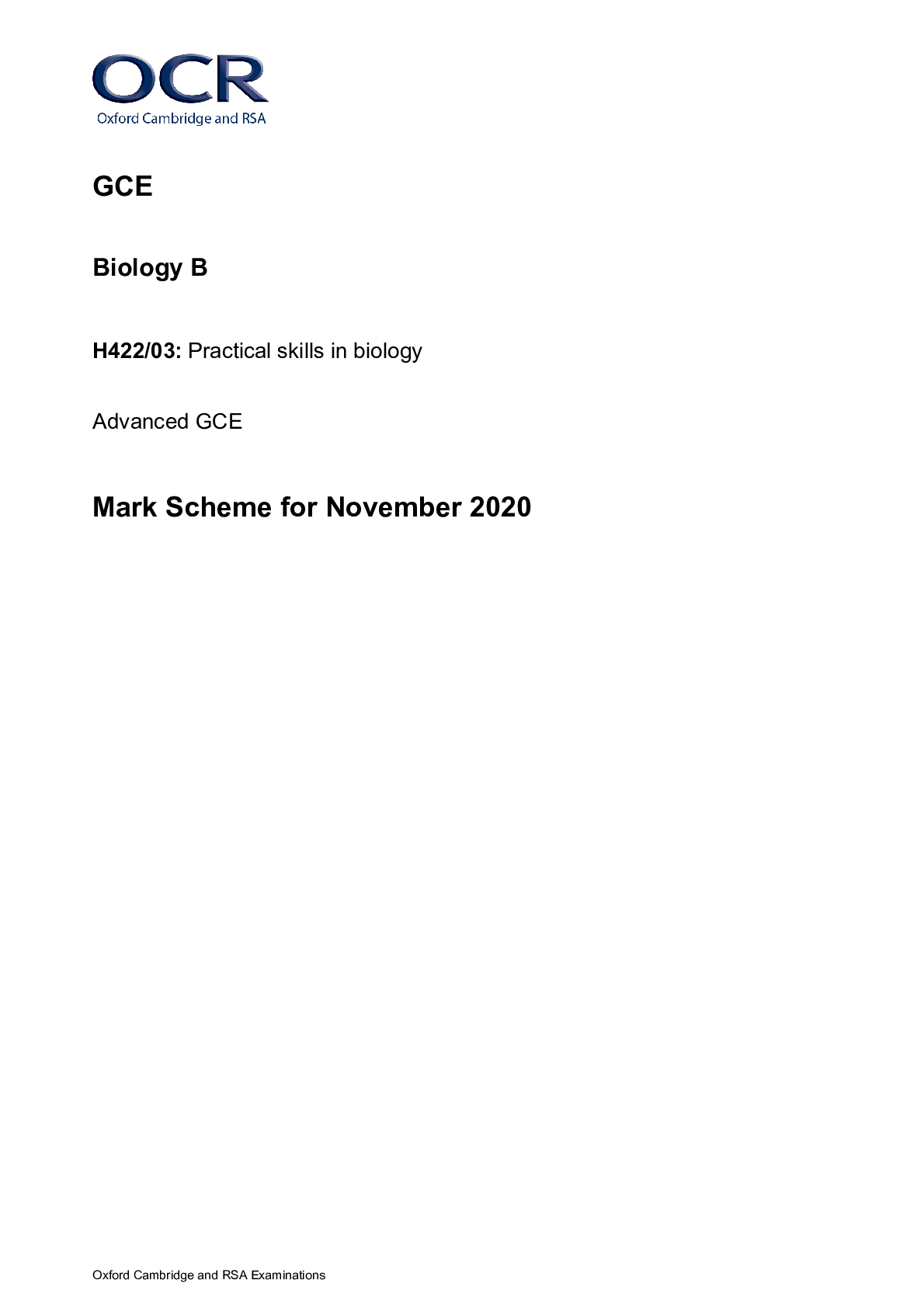
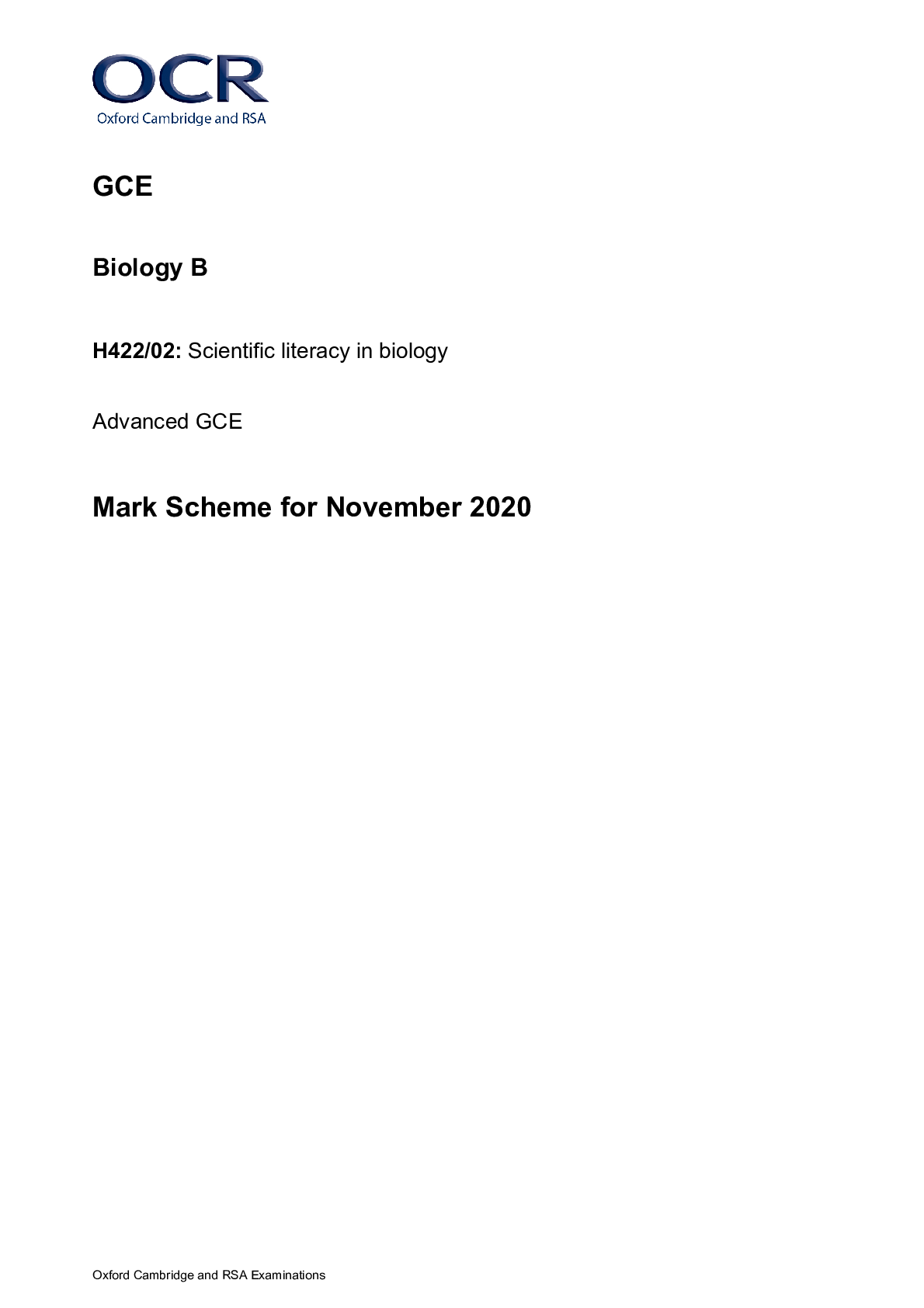
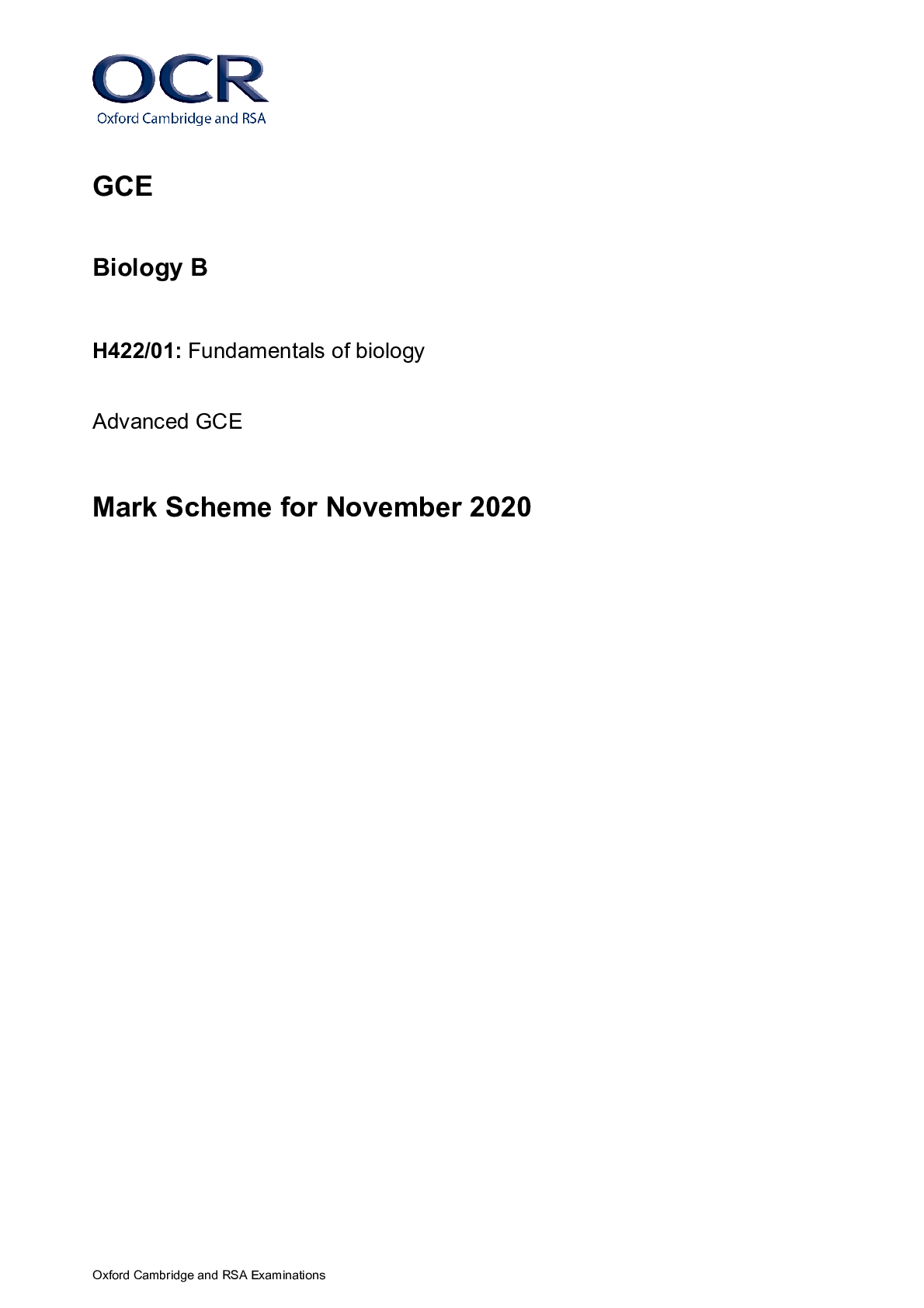

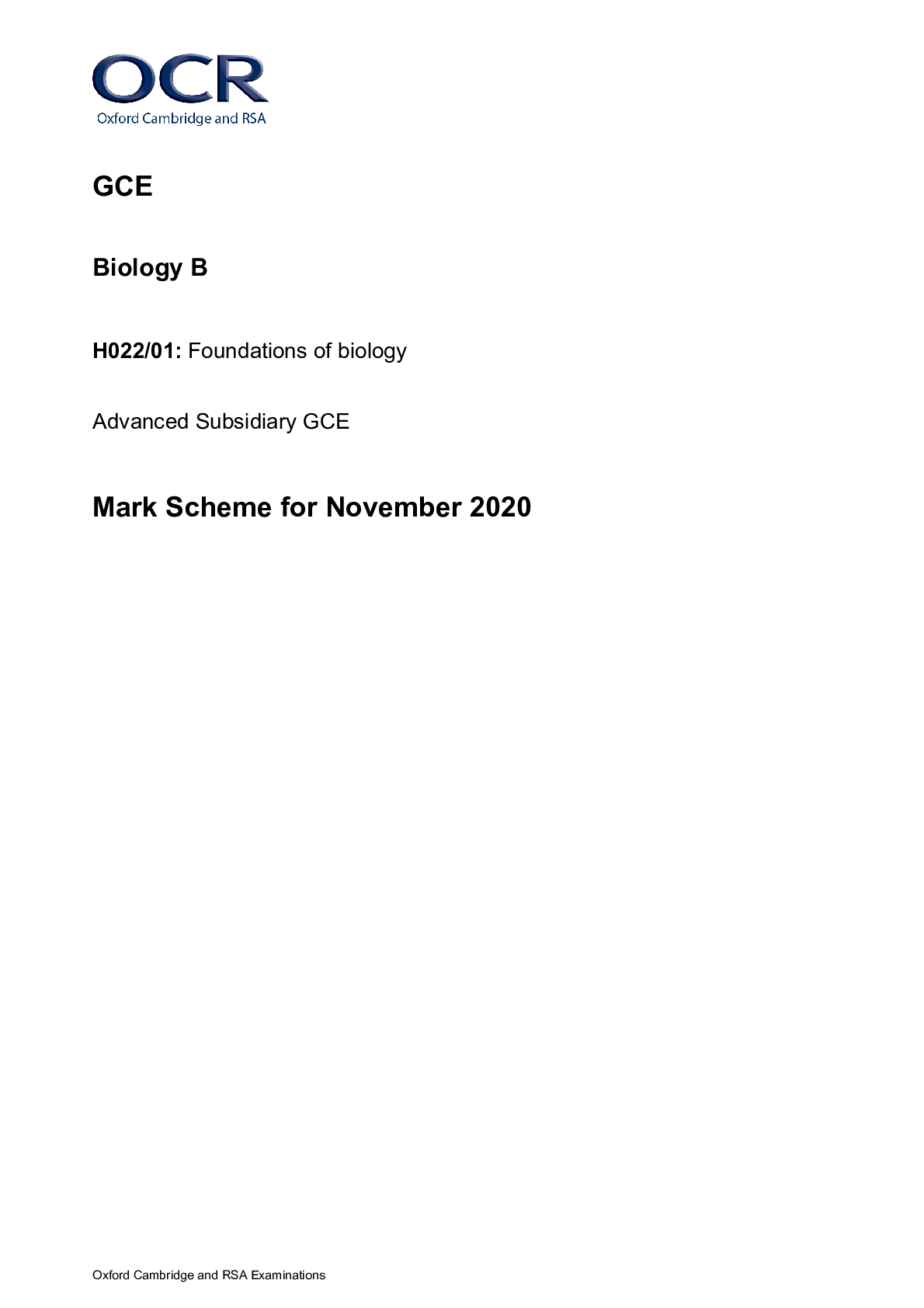
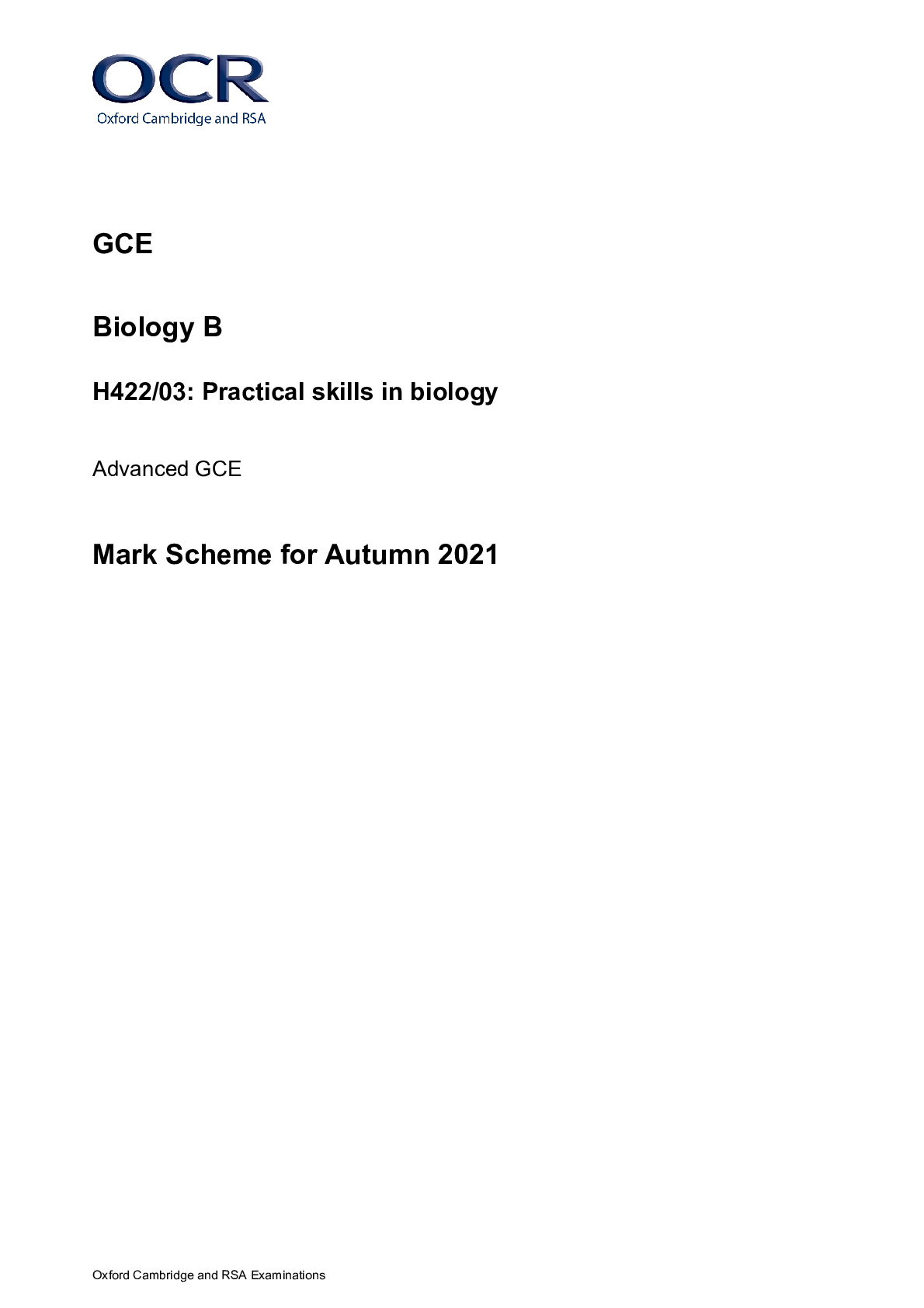
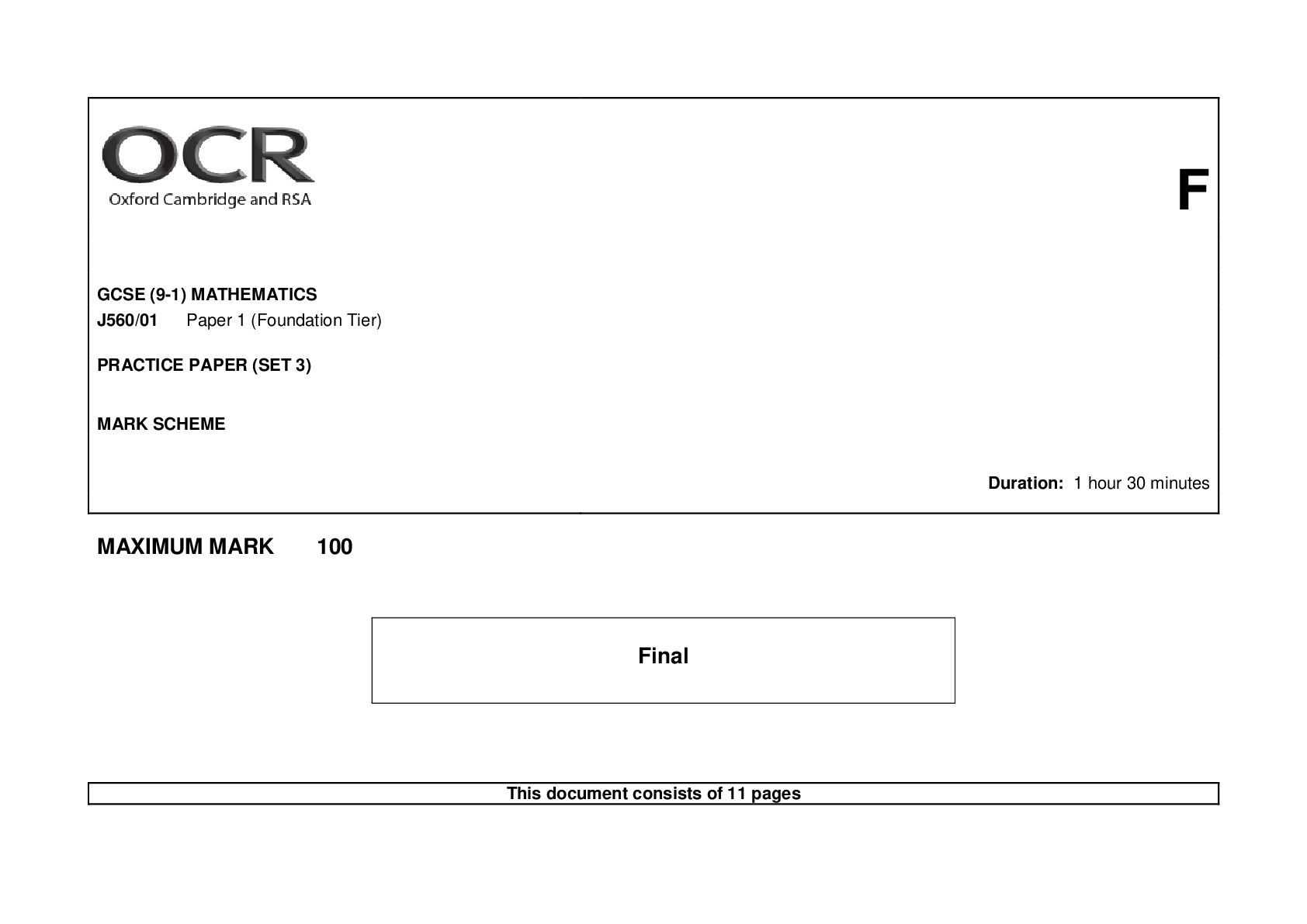
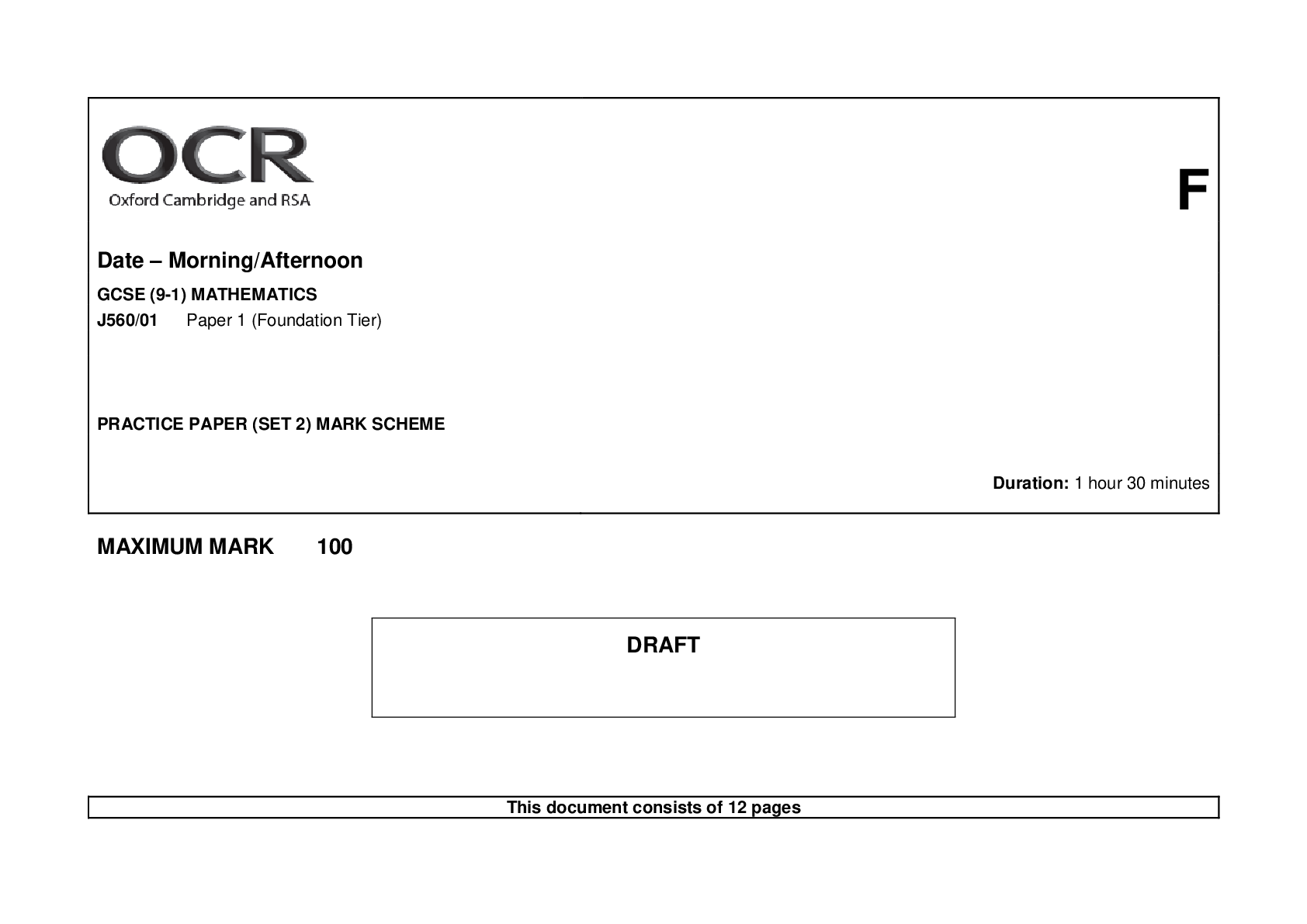
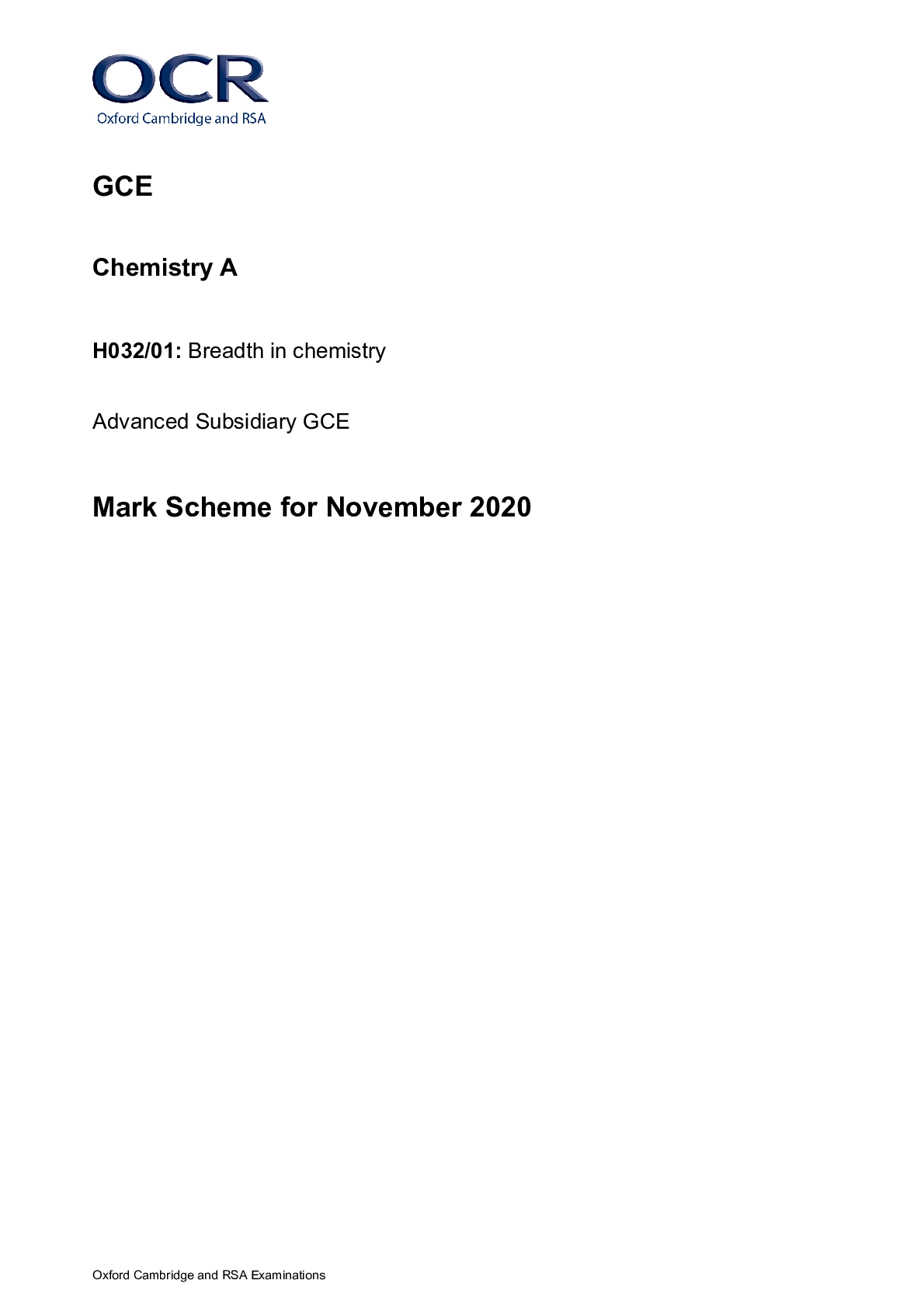

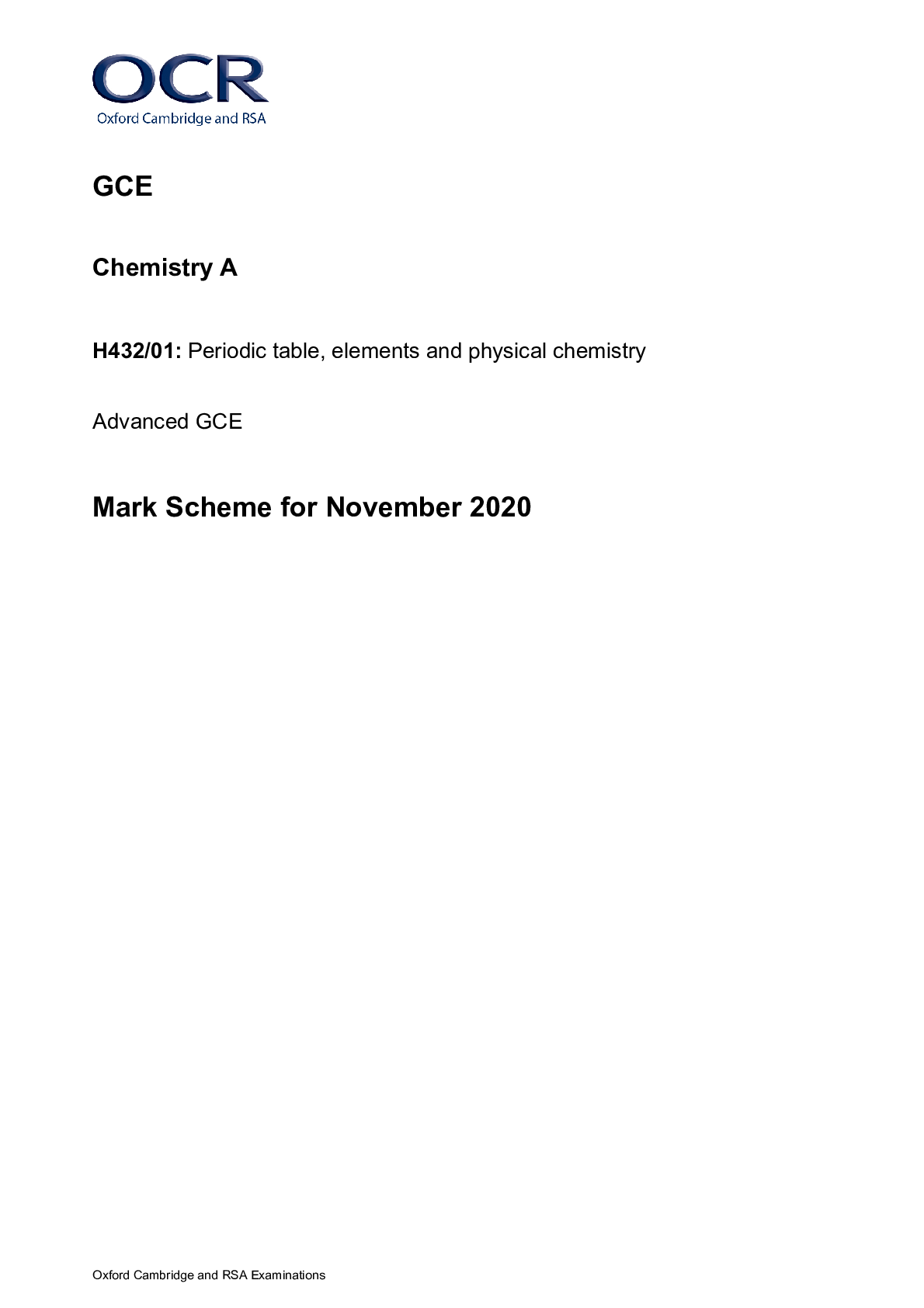
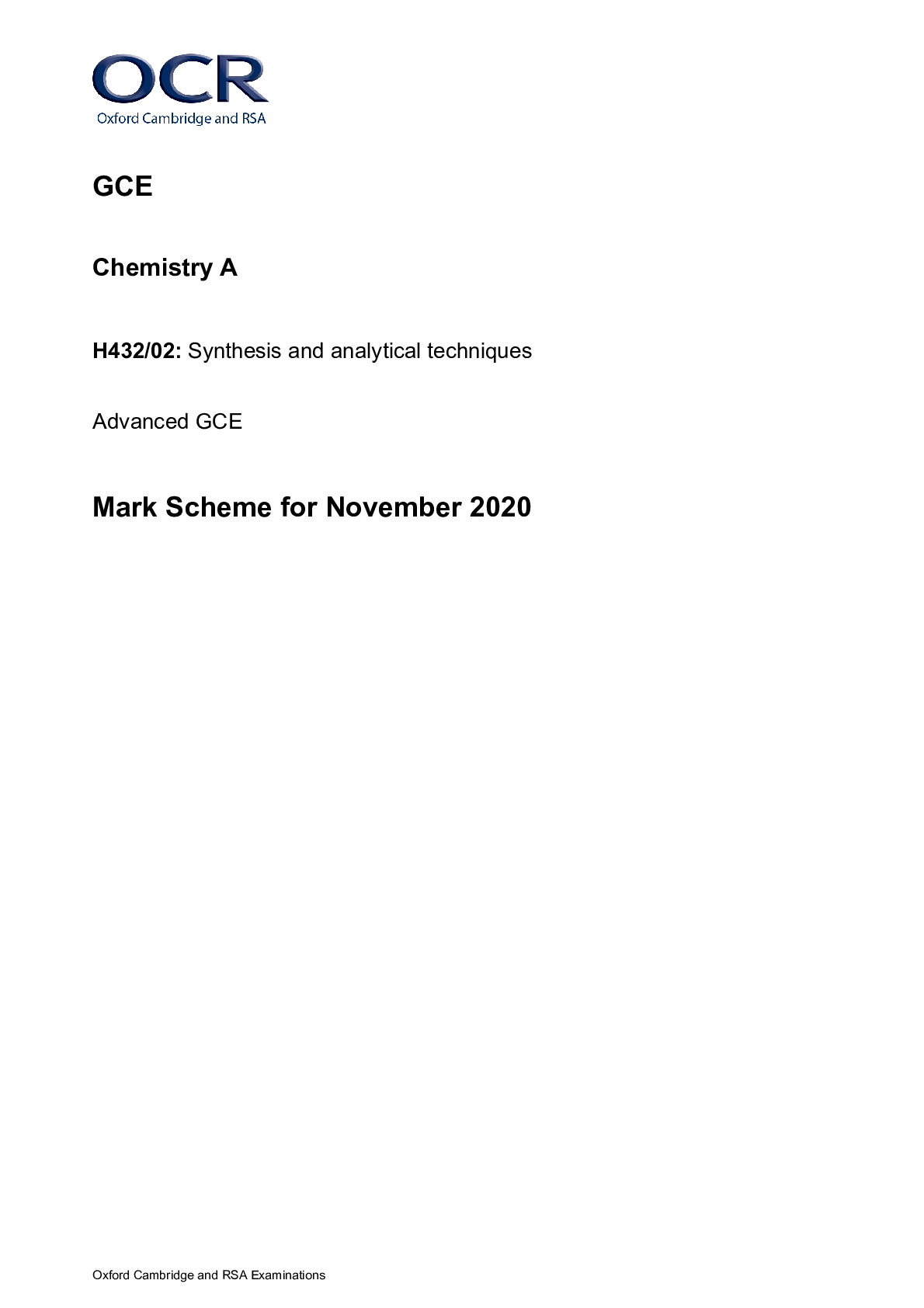

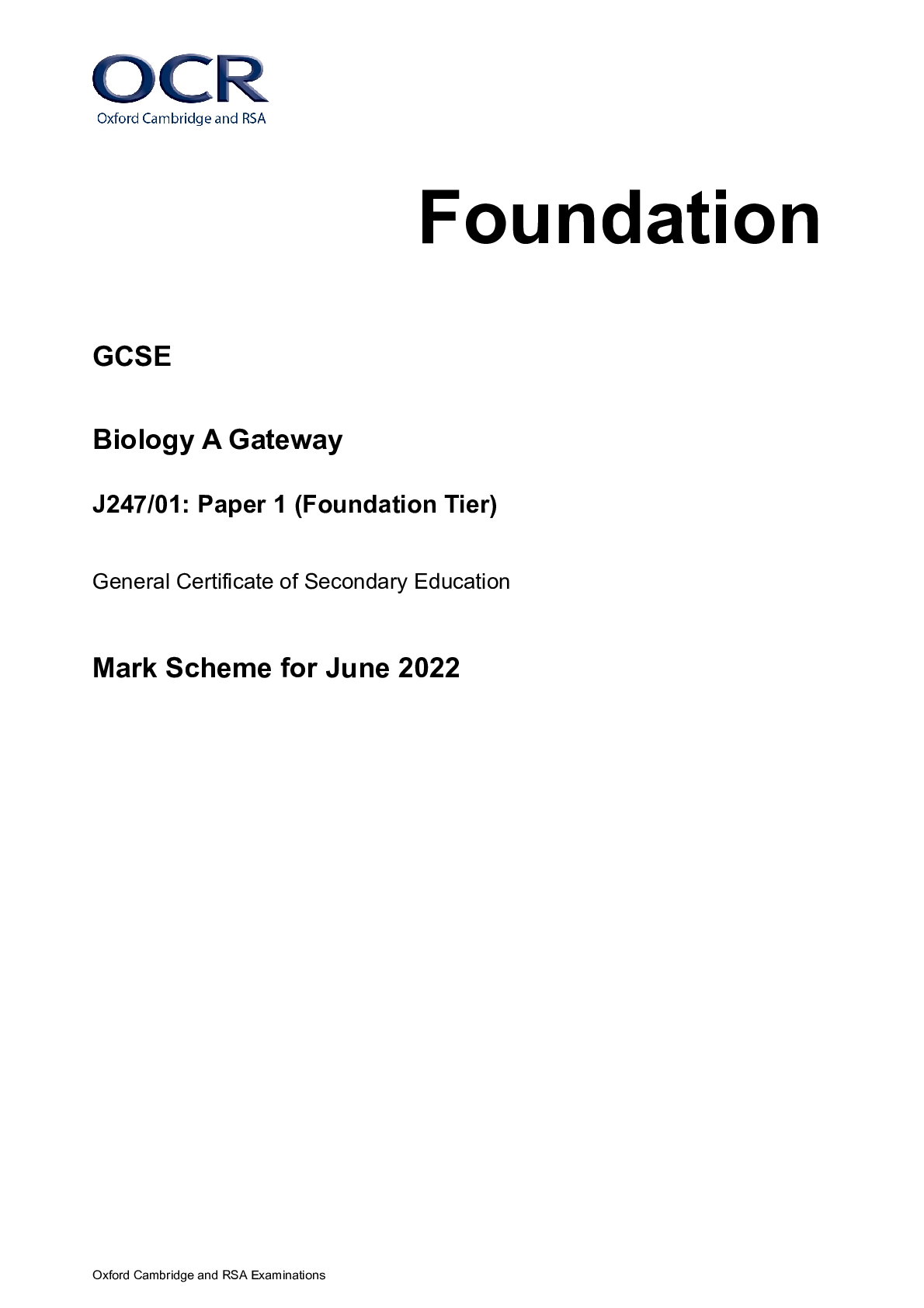
H630-02 Pure Mathematics and Statistics Advanced Subsidiary GCE Mark Scheme for Autumn 2021.png)


.png)

